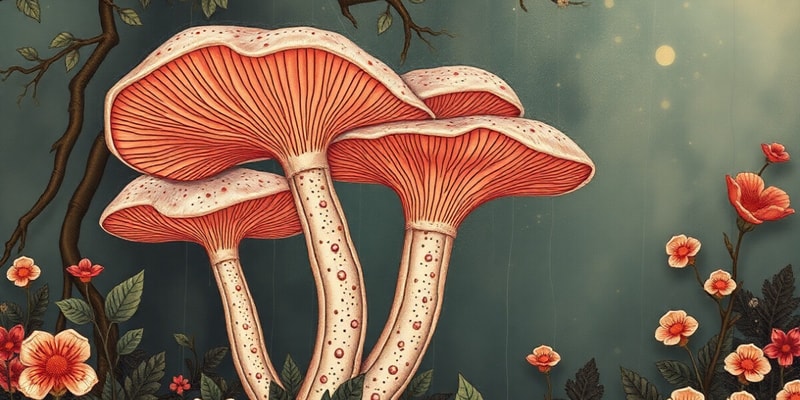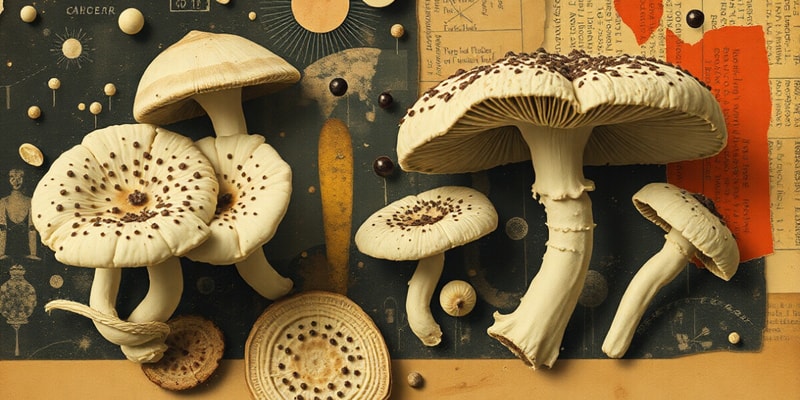Podcast Beta
Questions and Answers
What is the primary role of basidia in fungi?
Which type of lichen is characterized by a leaf-like structure?
What type of fungi are included in the category known as basidiomycetes?
In fungal structures, what primarily composes the mold body?
Signup and view all the answers
What is the main function of the mushroom's fruiting body?
Signup and view all the answers
What is the main function of hyphae in fungi?
Signup and view all the answers
Which of the following fungal groups is known for forming mycorrhizal relationships with plants?
Signup and view all the answers
What characterizes the dikaryotic phase in fungal reproduction?
Signup and view all the answers
What type of spores do ascomycetes produce during asexual reproduction?
Signup and view all the answers
Which statement accurately describes the reproductive structures of Mucoromycetes?
Signup and view all the answers
Which characteristic is NOT typical of glomeromycetes?
Signup and view all the answers
Which term describes the process by which two fungal cells combine their cytoplasm without immediately fusing their nuclei?
Signup and view all the answers
What role do haustoria play in fungi?
Signup and view all the answers
Which group of fungi is primarily responsible for the infections observed in amphibian populations?
Signup and view all the answers
In which phase do many fungi produce a wide variety of spores for distribution?
Signup and view all the answers
What is the primary feature that differentiates saprobes from other fungi?
Signup and view all the answers
What defines a coenocytic hypha?
Signup and view all the answers
Which of the following processes occurs during karyogamy?
Signup and view all the answers
Which type of fungal structure is found in ascomycetes?
Signup and view all the answers
Study Notes
Overview of Fungi
- Fungi are part of the Opisthokonts group, which is part of the Unikonta supergroup.
- Eukaryotic heterotrophs: obtain nutrition from consuming organic matter.
- Cell walls composed of chitin, which is also found in the exoskeletons of insects.
- Can be single-celled (yeasts) or multicellular (molds and mushrooms).
- Absorptive heterotrophs: secrete digestive enzymes into the surrounding environment and absorb the digested molecules.
- Hyphae: thin filaments of cytoplasm and nuclei that maximize surface area for nutrient absorption.
- Septa: cross-walls that divide hyphae into cells, but contain pores for the movement of cellular components.
- Haustoria: specialized hyphae that penetrate into other organisms to exchange or collect nutrients.
- Mycelium: a network of hyphae that forms the primary body of the fungus.
- Fungi reproduce both sexually and asexually.
- Dikaryotic phase: a brief diploid phase where two different mating types fuse their cytoplasm (plasmogamy), but their nuclei remain separate.
- Karyogamy: the fusion of nuclei to form a diploid cell, which undergoes meiosis to produce diverse spores.
- Asexual reproduction occurs through spore production (budding) or fragmentation.
Fungal Diversity
- All fungi share general characteristics, including being absorptive heterotrophs and having cell walls composed of chitin.
- Groups are differentiated based on their spores: flagellated or non-flagellated.
Chytrids
- Usually aquatic fungi that are saprobes (consume dead organic matter).
- Can be single-celled or multicellular.
- Responsible for infections in amphibian populations, contributing to declines in amphibian species.
Zoopagomycetes
- Previously combined with Mucoromycetes.
- Primarily endoparasites: live within animal hosts.
- Example: Entomophthora, which infects flies and manipulates their behavior to climb high places for optimal spore dispersal.
Mucoromycetes
- Includes bread molds.
- Mainly coenocytic saprotrophs: have hyphae without cross-walls (one long cell) and obtain nutrients from decaying organic matter.
- Can be parasitic or commensal (living on a host without causing harm).
- Zygosporangia: large, dark-walled structures where karyogamy and meiosis occur.
- Zygosporangia can develop into stalks for spore dispersal.
Glomeromycetes
- Form mycorrhizae: symbiotic associations between fungi and plant roots.
- Mycorrhizae increase the surface area for nutrient and water uptake in plant roots.
- Two types:
- Ectomycorrhizal: fungi grow on the surface of plant roots, establishing connections with plant cells.
- Arbuscular: fungi grow directly into the tissues of plant roots.
- Plants provide fungi with organic molecules (carbohydrates and amino acids).
- Mycorrhizae increase plant growth rate and size.
- Glomeromycetes do not reproduce sexually (no fruiting bodies).
- Coenocytic hyphae: not divided into compartments.
- Obligate symbionts: dependent on another organism for survival. Glomeromycetes are dependent on plants.
Ascomycetes
- Asci: cup-like or sac-shaped reproductive structures.
- Include yeasts, some molds, morels, and truffles.
- Examples: Cordyceps (parasitic fungi) and Penicillium (source of penicillin antibiotic).
- Conidia: spores produced on conidiophores (modified hyphae) for asexual reproduction.
- Lichens: symbiotic associations between three organisms:
- Fungi provide structure and protection
- Algae or cyanobacteria provide photosynthetic capabilities
- Other organisms contribute to water and nutrient absorption.
- Lichens allow fungi to colonize a wide range of habitats.
Basidiomycetes
- Club fungi: includes puffballs, shelf fungi, and pathogenic rusts and smuts.
- Basidium: sexual reproductive structure that produces spores.
- Found within the gills of the basidiocarp (fruiting body or mushroom).
Fungal Structure
-
Mold body:
- Composed of filamentous mycelium.
- Requires penetration into a growth substrate.
-
Mushroom body:
- The fruiting body of the fungus.
- Produces spores for reproduction.
- The main body (mycelium) is located underground.
- Displays filamentous growth patterns.
Studying That Suits You
Use AI to generate personalized quizzes and flashcards to suit your learning preferences.
Related Documents
Description
Explore the fascinating world of fungi, part of the Opisthokonts group and essential eukaryotic heterotrophs. This quiz covers their unique structures, nutritional methods, reproductive strategies, and ecological roles. Test your knowledge on yeasts, molds, mushrooms, and their intricate life processes.




